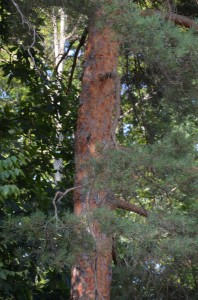Mugho, aka mugo pine (Pinus mugo), and Scots pine (P. sylvestris) are two troubled pines which gardeners in the Southern Appalachian region (USDA Hardiness zones 6 and 7) have shied away from planting. Both have become problem growers over the past quarter century. Scots pine suffers from several devastating foliar diseases. Once a popular Christmas tree, it is no longer grown.
Mugo pines have problems with poor soil drainage, phytophthora root rot and Cylindrocladium root rot. Newly planted mugos generally live 3-5 years before they start to decline due to root weevils and other root-related diseases.
Cyclaneusma needle cast is the devastating disease of Scots pine in the mid-South region of the U.S. Diplodia tip blight has also been a problem. Often, latent infections of Diplodia don’t show up for several years. Scots pine is no longer grown as a Christmas tree; fraser fir (Abies fraseri) and white pine (P. strobus) have replaced Scots pine in the Christmas tree marketplace.
Fortunately, many pines, including the ubiquitous white pine, perform well in the region. Some favorites in my east Tennessee garden (zone 6-b) include: lacebark pine (P. bungeana), several forms of Japanese red pine (P. densiflora), including cultivars ‘Jane Kluis’ and dragon-eye ‘Oculis Draconis’, Bergman Japanese white Pine (P. parviflora ‘Bergman’), and Vanderwolf Pyramid limber pine (P. flexilis ‘Vanderwolf Pyramid’).
Source: Special thanks to Dr. Alan Windham, University of Tennessee Plant Pathologist, Nashville, TN.


 Posted in
Posted in 
